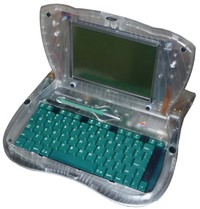Apple eMate 300 Prototype designated A2015
| Home > Browse Our Collection > Computers > Apple Computers > Apple eMate 300 Prototype designated A2015 |
|
Dubbed the eMate 300, the device was shipped with a solid dark green casing as opposed to the clear casing of this particular model. Very few of these see-through eMates were ever produced, making this one a very rare exhibit. Originally designed as a low-cost device for the education market, it also appears to have inspired the design of the clamshell iBook laptops released back in the 1990s. Either way a seller listed this eMate 300 for a of $8,499.99 on eBay. Vintage PROTOTYPE Apple Computer eMate 300 PDA Laptop. Approx. circa 1996-1997. The eMate 300 laptops were originally planned to be made in Green, Clear, Red, Purple, & Orange colours. Only the dark green eMates made it into production. This pre-production prototype has a clear case. There are a few small dark green panels (ie. next to the keyboard, and the port surrounds on the sides) which demonstrate what the standard colour eMate. It has prototype designation on the bottom & the FCC did eventually approve the eMate). Allegedly only six of these clear case prototypes were ever made. After they were no longer needed, they were awarded to those involved with the eMate project. Comes with the eMate Stylus. The eMate 300 was a personal digital assistant designed, manufactured and sold by Apple Computer to the education market as a low-cost laptop running the Newton operating system. The eMate was introduced March 7, 1997, for US$800 and was discontinued along with the Apple Newton product line and its operating system on February 27, 1998 The eMate 300 featured a 480x320 resolution 16-shade grayscale display with a backlight, a stylus pen, a full-sized keyboard, an infrared port, and standard Macintosh serial/LocalTalk ports. Power came from built-in rechargeable batteries, which lasted up to 28 hours on full charge. In order to achieve its low price, the eMate 300 did not have all the features of the contemporary Newton equivalent, the MessagePad 2000. The eMate used a 25 MHz ARM 710a RISC processor and had less memory than the MessagePad 2000 which used a StrongARM 110 RISC processor and was more expandable. The eMate 300 featured a green-colored translucent durable case designed for intense use in classrooms. The eMate 300 featured a dark green-colored keyboard similar to that of PowerBooks of the same era. Purple, red, and orange colored eMate prototypes were produced especially for show only and were never put into mass production The Apple eMate 300, designed for the education market, features a 25 MHz ARM 710a processor, 8 MB of ROM, 3 MB of RAM (1MB of DRAM, 2 MB of Flash Memory for user storage), a PCMCIA slot, IrDA-beaming capabilities, and a Newton InterConnect port for multiple connectivity options, in a translucent aquamarine and black "clamshell" portable case with a 480x320 16-shade grayscale backlit LCD display for use with either a provided stylus or the built-in keyboard. The eMate is the only Newton model to resemble a traditional laptop rather than a handheld, but had the Newton line continued, additional models would have likely followed. Please note that eMate is technically not a 'Mac', as it does not operate the MacOS, and instead uses the NewtonOS (also developed by Apple). The eMate's unusual design eventually influenced the first iBook series, which also featured durable plastic casing with a handle. Further information can be found at http://www.cultofmac.com/161046/you-can-buy-this-funky-looking-apple-prototype-emate-300-for-only-8500/ Manufacturer: Apple Comment on This Page Magazines RELATED to Apple eMate 300 Prototype designated A2015 in our Library
Other Systems Related To Apple eMate 300 Prototype designated A2015:This exhibit has a reference ID of CH26487. Please quote this reference ID in any communication with the Centre for Computing History. |
|



























